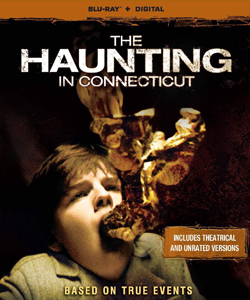“The Haunting in Connecticut” (2009) is – like the more famous “The Amityville Horror” (1979) — another of those proto-“Conjuring” films that come from an Ed and Lorraine Warren investigation, although they have no presence in the film. By comparing it to “Amityville” we see how a haunted-house story can emphasize different things.
In “Amityville,” we don’t know why the house is haunted; the scares and creepiness are the thing from start to finish. In “Connecticut,” the backstory of why this bargain-basement fixer-upper is haunted is steadily explored; the mystery is the thing. (Granted, it’s not the wildest mystery. The fact that the house used to be a funeral home is a pretty glaring opening clue.)
The mystery is the thing
Director Peter Cornwell and writers Adam Simon and Tim Metcalfe adapt a book by Ray Garton (1992’s “Dark Place: The Story of a True Haunting”). Garton’s book (co-authored with the Warrens, whose names are bigger on the cover, natch) is based on a true (or “true”) story of a 1986 haunting of the Snedeker family. Garton later admitted Ed Warren told him to fictionalize whatever he needed to in order to make it scary.

“The Haunting in Connecticut” (2009)
Director: Peter Cornwell
Writers: Adam Simon, Tim Metcalfe; based on the book by Ray Garton
Stars: Virginia Madsen, Martin Donovan, Elias Koteas
Like a game of telephone, the filmmakers are at the end of a long line of tellers of this ghost story – from the Snedekers to the Warrens to Garton to them. Whew.
Truthfulness aside, this is a decently scary yarn, with one particularly excellent jump scare. I think a big reason why “Connecticut” isn’t talked about as much as other haunted-house films is that it’s so polished in both look and narrative. It takes place in 1986, but you’d never know it. By comparison, 2013’s “The Conjuring” feels like 1971. (And “Amityville” feels like the Seventies and “Poltergeist” feels like the Eighties, but of course they were made in those times.)
“Connecticut” has such a perfect metaphor at its heart that the fictional nature becomes evident. Teenager Matt (Kyle Gallner, who steadily pops up in horror films) has cancer, and he can also see ghosts. His vomiting parallels mediums’ spewing of ectoplasm when in the presence of spirits. Solving the mystery might help Matt get well.
The film’s message is literally stated by Virginia Madsen’s Sara in a voiceover: God works in mysterious ways. In grittier and better horror films, things aren’t so tidy: The Devil is a serious, chaotic counter to God’s plan.
A tidy metaphor
If the Warrens were in the practice of shaping their investigations into compelling fiction, the Snedeker haunting might be their best in terms of yarn-spinning, but their worst in terms of verisimilitude.
Judging it for the story that it is, “Connecticut” does a lot of things right, starting with a likeable family – with Madsen and Gallner looking very much like mother and son. The alcoholic dad, Peter (Martin Donovan), is perhaps a cliché since “The Shining,” perhaps just a trope.
Speaking of tropes, the family must stay in this absurdly haunted house. The reason is valid: The Campbells need an affordable place to rent near the hospital where Matt gets his treatment. Their financial plight is further illustrated when Peter sells his shiny truck for an old beater.
One of the four Campbell kids is actually a niece, whom they’ve taken in. The Campbells – or at least Sara – always are driven to do the right thing, and this might be their downfall. Adding a calming element is the always-welcome Elias Koteas (“TMNT” 1990). He plays a cancer-stricken reverend who, like Matt, has glimpsed “the borderlands” of the spirit realm. He’s the closest thing to a stand-in for the Warrens.
Pretty much every character in the film is likeable. This is a shortcut toward a viewer liking “The Haunting in Connecticut.” Throw in the mystery, and it’s a satisfying experience. But it’s also a slick and tidy one, and truly great horror shouldn’t leave us feeling so at ease.


